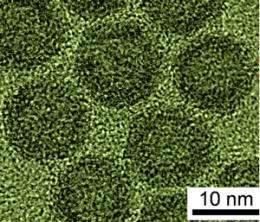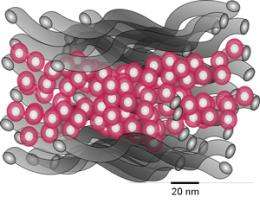Hollow iron oxide nanoparticles for lithium-ion battery applications

Novel hollow iron oxide nanoparticles with a high concentration of defects were synthesized by Center for Nanoscale Materials (CNM) facility users from Argonne's Chemical Sciences & Engineering Division and Advanced Photon Source (APS), and the University of Chicago, working collaboratively with the CNM NanoBio Interfaces Group. A new concept of electrode fabrication based on sealing nanoparticles between layers of pure carbon nanotubes was also developed. When this novel electrode was used as a cathode, the inherent iron vacancies allowed for significantly increased performance in a lithium-ion battery.
Conventional nanoparticle-based electrodes fade quickly because of poor connectivity between the nanoparticles and the current collector. The new electrodes allow for reversible lithium-ion intercalation, which resulted in high capacity and efficiency, superior rate performance, and excellent stability (no fading over more than 500 cycles). This result demonstrates that nanomaterial morphology is critical to lithium-ion battery development.

At the CNM, hollow gamma-Fe2O3 nanoparticles were synthesized with four times more cation vacancies than solid nanoparticles or bulk material. Novel electrode fabrication involved sealing the nanoparticles between layers of pure multiwalled carbon nanotubes without binders or additives. Electrochemical studies revealed high capacity (132 mAh/g at 2.5V), 99.7% Coulombic efficiency, superior rate performance (133 mAh/g at 3000 mA/g), and excellent stability. At the APS, in situ structural transformation of the nanoparticles by synchrotron X-ray absorption and diffraction techniques provided a clear understanding of lithium processes during electrochemical cycling.
More information: B. Koo et al., "Hollow iron oxide nanoparticles for application in lithium ion batteries," Nano Letters,12, 2429 (2012)
Journal information: Nano Letters
Provided by Argonne National Laboratory





















